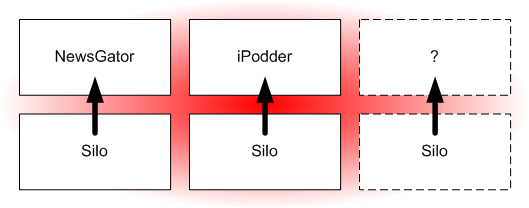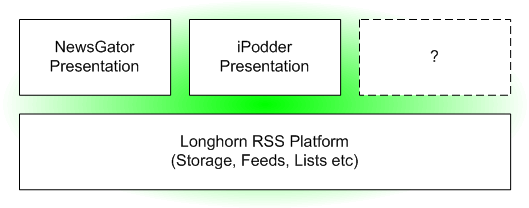I’ve already posted up about the RSS support that is going to be built into the Windows platform for the Longhorn release, and it looks like the news is getting a fair bit of airplay across the blogosphere and even in traditional news sources.
Most of the commentry in the blogosphere falls into two buckets:
- This is a good thing (tm).
- This is a bad thing (tm).
There are a few posts like Nick Bradbury’s which are very insightful, and it inspired this post. Personally I think it (the RSS platform) is a good thing, but not because I am a one eyed .NET freakazoid that loves any new API in my platform of choice. No – its because aggregators today both online and offline lock you in, its about voice of visualisation!
Over the past eighteen months I’ve used a couple of tools to grab my RSS feeds depending on what they are. For text-based content I was using NewsGator, for Podcasts I was using iPodder or Doppler and then there were a few other little tools that were RSS aware.
The problem is that each one of these applications represents an information silo which is inaccessible to other applications. For example, iPodder can’t look at the RSS items that NewsGator has already downloaded and automatically (based on preferences) start downloading the podcasts. If you could visualise the current state of affairs it would look something like the following diagram.

And this is only offline aggregators, online aggregators are much worse because you can’t even get your hands on the data, its locked away from you in some data-centre. At least with the offline aggregators there tend to be some XML files hanging around that you can parse to extract the information. In the future we won’t even have to do that.
Like any good platform the new RSS features in Longhorn down into the underlying operating system allowing application developers to focus on how they want to use information versus how they are going to store it and continually receive feeds (who wants to run their aggregator all day anyway). If you could visualise the Longhorn model it would look something like the following diagram.

Why am I writing this post? Well I think what Microsoft is doing here is a good thing, even if you hate Microsoft you have to love the scenario they are enabling here. They are building a platform that encourages users to take ownership of their information – but perhaps more importantly are allowing users to see that information in a way that is useful to them.
With Longhorn schedule for release some time next year its time for software developers to start factoring platform enhancements like these into their future plans.